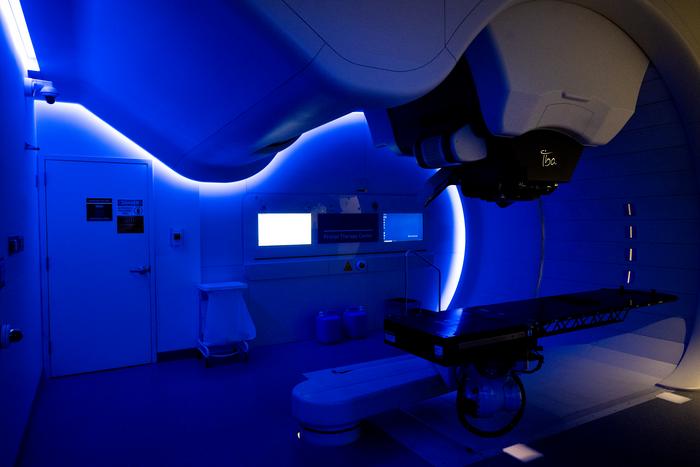In a groundbreaking advancement that could redefine the future of cancer treatment, Corewell Health William Beaumont University Hospital in Royal Oak, Michigan, has successfully implemented the first clinical use of step-and-shoot proton arc therapy to treat a patient with a challenging form of head and neck cancer. This novel radiation technique promises to deliver highly precise doses of proton radiation with unprecedented accuracy, dramatically reducing the collateral damage typically associated with conventional radiation therapies.
Step-and-shoot proton arc therapy operates by using a proton beam that continuously adjusts its angle and intensity around the patient, targeting the tumor in a dynamic arc. Unlike older proton therapy methods that involve labor-intensive, manually controlled beam deliveries, this technology automates the radiation process, minimizing lag time between exposures and eliminating pauses that can affect dose precision. As a result, the treatment can lock onto the tumor with remarkable exactness, sparing surrounding healthy tissue and critical organs from unnecessary radiation exposure.
The patient treated with this new therapy, Tiffiney Beard, a 46-year-old from Redford, Michigan, was diagnosed with adenoid cystic carcinoma—a rare and notoriously invasive tumor arising in the salivary glands. These tumors have an insidious nature, often growing along nerves and invading critical structures, which significantly complicates treatment efforts. Traditional radiation treatments for such tumors carry a heavy burden of side effects, including fatigue, jaw pain, difficulty swallowing, loss of taste, headaches, and cognitive impairments.
Dr. Rohan Deraniyagala, the radiation oncologist leading this innovative case study, emphasized the challenges in managing adenoid cystic carcinoma due to its neurotropic behavior. The tumor in Beard’s case had infiltrated nerves extending toward the brain, increasing the risk of severe neurological complications during treatment. Conventional therapy approaches often struggle to balance tumor control with the preservation of nerve function and quality of life.
What sets the step-and-shoot proton arc therapy apart is its capacity to deliver a highly conformed radiation dose that adapts in real-time, precisely sculpting the radiation to the tumor’s shape while dynamically avoiding critical neural pathways. This precise targeting is paramount in tumors intimately associated with nerve bundles. Beard underwent a rigorous treatment schedule of 33 sessions, each lasting approximately 30 minutes, delivered five days a week over a three-month period. Remarkably, she reported virtually no side effects aside from mild skin discoloration, a testament to the therapy’s tissue-sparing capabilities.
The clinical outcome for Beard is extraordinary: post-treatment evaluations show no evidence of residual or recurring cancer, and crucially, she exhibits no signs of radiation-induced toxicity beyond the localized skin changes. This represents a significant departure from the conventional expectations where many patients endure debilitating reactions. The efficient nature of this treatment also allowed Beard to continue working and maintain her family life, highlighting a major quality-of-life improvement.
This pioneering clinical application is not only a beacon of hope for patients with adenoid cystic carcinoma but also provides compelling evidence supporting the broader adoption of step-and-shoot proton arc therapy for various malignancies situated in complex anatomical regions. The continuous, automated delivery system represents a significant technological leap that could become a new standard in proton therapy protocols.
Furthermore, Corewell Health’s collaboration with Ion Beam Application, a leader in proton therapy technology, is pushing the frontier even further. Together, they are developing DynamicARC®, a next-generation proton beam therapy platform designed to eradicate any residual lag time between radiation doses and deliver ultra-precise, uninterrupted proton beams. Expected to receive FDA approval next year, DynamicARC® is anticipated to enhance treatment effectiveness while further reducing side effects.
The implications of these advancements extend beyond patient convenience and clinical outcomes. By reducing radiation exposure to healthy tissue, these cutting-edge proton therapies also diminish the risk of long-term complications such as secondary malignancies and permanent neurological damage. This marks an essential step forward in the evolution of oncologic radiation therapies, marrying technological innovation with patient-centered care.
Tiffiney Beard’s successful treatment underscores a critical paradigm shift: cancer therapies are moving toward more personalized, targeted techniques that prioritize not only eradication of disease but also preservation of the patient’s overall well-being. As Dr. Deraniyagala points out, “While this step-and-shoot proton arc therapy is a significant milestone, it is just the beginning of a new era in precision radiation oncology.”
The case study detailing this pioneering treatment has been published in the International Journal of Particle Therapy and is set to be presented by Dr. Deraniyagala at the International Symposium on Proton Therapy in Philadelphia, as well as at the Particle Therapy Cooperative Group annual meeting in Buenos Aires. This research promises to catalyze further investigations and clinical trials that will refine proton therapy techniques and expand their applications.
Corewell Health’s William Beaumont University Proton Therapy Center is now at the forefront of these transformative efforts, blending clinical expertise with advanced technology to redefine cancer treatment paradigms. Patients interested in proton therapy and its potential benefits are encouraged to connect with the center’s nurse navigators to explore personalized treatment options.
As proton therapy modalities rapidly evolve, the promise they hold for enhancing cancer treatment efficacy and reducing patient suffering grows ever clearer. The step-and-shoot proton arc approach exemplifies how innovation in radiation delivery can translate into tangible improvements in clinical outcomes and quality of life, bringing hope to patients facing some of the most difficult cancers.
Subject of Research: People
Article Title: First Clinical Implementation of Step-and-Shoot Proton Arc Therapy for Head and Neck Cancer Treatment
News Publication Date: April 23, 2025
Web References: International Journal of Particle Therapy Article
References: DOI 10.1016/j.ijpt.2025.100749
Image Credits: Emily Rose Bennett, Corewell Health
Keywords: Radiation therapy, Proton mass, Side effects, Radiation poisoning, Health care delivery, Cancer patients, Technology, Tumor tissue, Carcinoma, Salivary glands




